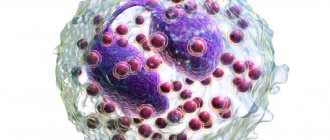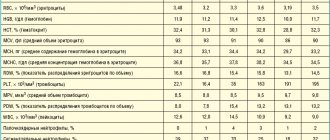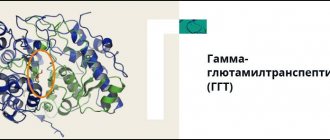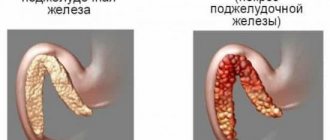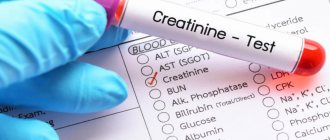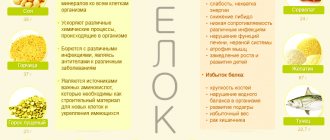Gamma-glutamyl transpeptidase (GGT, GGTP) is one of the indicators in liver studies, which is characterized as a protein enzyme involved in the metabolism of amino acids.
The concentration of this enzyme occurs mainly in liver cells, kidneys and pancreas. Its lower concentration is observed in the brain, heart cavities, intestines and spleen.
This indicator is significant when diagnosing liver disorders. The identical name is gamma-glutamate transferase, and the determination occurs in a biochemical blood test or liver tests.
GGTP - what kind of compound is it and what functions does it perform?
What is this?
GGTP stands for gamma-glutamyl transpeptidase. Sometimes this indicator is called GGT, which stands for gamma-glutamyl transferase. Both of these names refer to the same enzyme.
Where is it formed
This enzyme can be found in the nephron tubules of the kidneys, in the epithelium lining the bile ducts. Most of it is found in liver cells. Therefore, when these tissues are damaged, the enzyme enters the blood, which allows the doctor to diagnose a malfunction of these organs.
Main functions
Glutamyltransferase is an enzyme. And the main role of an enzyme is to catalyze any reaction. GGT catalyzes reactions that transfer glutamyl to amino acids or other compounds. This transfer is very important in the metabolism of amino acids: the enzyme promotes their transport, for example, through the intestinal wall from its lumen into the blood.
Why are the numbers falling?
A decrease in such an indicator as glutamine aminotransferase is quite rare. And it is due to one of three reasons:
- Hypothyroidism is a pathological condition of the thyroid gland in which it produces an insufficient amount of hormones - thyroxine and triiodothyronine - which leads to a malfunction in the body's metabolic processes,
- Use of certain medications
- GGT is reduced in patients undergoing treatment for alcohol addiction after a month of therapy.
When is a test to determine GGTP prescribed?
The determination of this type of transferase can be prescribed separately or in combination with other liver enzymes, for example, aspartate aminotransferase or alanine aminotransferase, to diagnose the condition of the hepatobiliary tract.
This enzyme has great diagnostic value in diagnosing diseases of the liver and biliary tract in such categories of people as children and pregnant women, since other liver enzymes increase at a physiological level.
Glutamyl transpeptidase activity also increases when the liver is exposed to toxic substances, such as certain medications or alcohol. This way you can understand whether the liver damage was caused by alcohol or not.
Glutamyltransferase is not found in bones. Accordingly, the level of GGT will not be affected by bone tissue pathology. This allows us to search for reasons for the increase in another enzyme - alkaline phosphatase.
Alkaline phosphatase is a diagnostic indicator of bone tissue pathology or damage to the hepato-biliary system.
GGT also makes it possible to assess the state of the kidneys, and if their functioning is disrupted, this enzyme will indicate this to the doctor.
Thus, gamma-glutamyltransferase makes it possible to carry out differential diagnosis of conditions that cause disruption of the liver, pathology of the kidneys and biliary tract.
Results
The liver is an intermediary between the gastrointestinal tract, which receives various substances, and the human body as a whole. The liver is the organ that is directly involved in metabolism.
Liver enzymes AlT, GGT, AST help it cope with various harmful substances, neutralizing them. While the liver is healthy, people do not try to help it maintain its normal condition. They begin to pay attention to the organ only after it is damaged to one degree or another. Until that point in time, a person poisons his liver for many years.
If liver tests and enzymes increase, you should think about the state of your health and continue the examination in order to try to eliminate the pathology in time.
Author of the article:
Shutov Maxim Evgenievich |
Hematologist Education: Graduated from Kursk State Medical University in 2013 and received a diploma in General Medicine. After 2 years, he completed his residency in the specialty “Oncology”. In 2021, she completed postgraduate studies at the National Medical and Surgical Center named after N.I. Pirogov. Our authors
Preparing for analysis
How to prepare?
The determination of gamma-glutamyltransferase refers to a number of biochemical blood tests. In order to obtain accurate information about GGT in the body, the patient must properly prepare for blood donation.
The preparation rules are very simple:
- For biochemical studies, blood should be donated on an empty stomach, that is, after an overnight fast for 10–12 hours. This way you can be sure that the blood will be suitable for research and will reflect the exact content of the test indicator in the blood;
- It is recommended not to smoke for several hours before blood collection;
- emotional experiences a day before the analysis can affect the accuracy of the research results;
- training and other physical overload of the body should be cancelled. They can also affect the final result;
- If the patient is prescribed medications, then you should consult a doctor - can they affect the level of the enzyme in the blood? The patient should not cancel or prescribe anything on his own!
Where is it for rent?
Blood sampling to determine the level of glutamyl transferase takes place in a special room at a medical institution. Most often this is a local clinic. This simple analysis can also be carried out in private medical organizations.
Price
When visiting a clinic at your place of residence, the determination of gamma-glutamyl transferase is carried out free of charge for patients with a compulsory medical insurance policy. If the patient expressed a desire to donate blood to determine the level of this enzyme in a private medical center, then the price for this analysis will be about 150 - 300 rubles.
Please remember that there is an additional charge for the blood collection procedure itself. On average, this will be about 150 – 300 rubles, depending on the region.
References
- Clinical guidelines for the diagnosis and treatment of cholestasis. Russian Gastroenterological Association Russian Society for the Study of the Liver, 2013
- Clinical recommendations “Alcoholic liver disease”: - Scientific Society of Gastroenterologists of Russia, Russian Scientific Medical Society of Therapists, 2021.
- Letter of the Ministry of Health of the Russian Federation dated November 2, 2021 N 15-4/10/2-7675 On the direction of clinical recommendations (treatment protocol) “Acute fatty liver degeneration in pregnant women: intensive care and obstetric tactics”, 2021.
- Anesthesia and intensive care for acute fatty liver degeneration in pregnant women Clinical guidelines. Treatment protocol: - Kulikov A.V., Shifman E.M., 2015
Analysis transcript
Norm for men and women
The normal range of gamma-glutamyltransferase levels differs between men and women. The norm for women is no more than 30 units per liter (U/L), and for men – no more than 50.
The reference values are provided for informational purposes only. You should not try to decipher the analysis results yourself. Let a specialist handle this.
Also, only approximate norms of GGTP were given above. In each laboratory, standards may differ depending on which test systems are used to determine the activity of this enzyme in blood serum.
Taking this into account, it is better to study GGT levels over time in the same clinical diagnostic laboratory.
Norms for children
Normal GGT levels are higher in children than in adults and vary depending on the age of the child.
In the first week of a child's life, the GGTP level should not exceed 180 units per liter. Then the enzyme level can increase, but not more than 200 units during the first half of the year.
By the first year of a child’s life, the level of gamma-glutamyl transferase decreases to a level of no more than 35 units per liter. During the growth and life of a child, the level of glutamyl transferase does not change much. Around the age of twelve, normal levels of the enzyme become the same as for an adult.
Complexes with this research
Male check-up No. 1 39 studies for annual preventive examination 18,920 ₽ Composition
Liver and pancreas Diagnosis of possible liver pathologies at an early stage 3,130 ₽ Composition
Biomarkers of liver functional capacity RUB 2,800 Composition
IN OTHER COMPLEXES
- Check-up No. 1 for children and teenagers 11,130 ₽
- Preventive check-up 6,300 ₽
- Biochemistry of blood. 13 indicators 4,110 ₽
- Healthy interest RUB 4,350
- Women's check-up No. 1 RUB 19,720
Deviation from the norm
A change in the activity of the enzyme glutamyltransferase above the reference values indicates pathology. In addition to diseases, taking medications can cause the indicator to deviate from the norm, but more on that later.
The higher the enzyme activity in the blood, the more severe the patient’s condition.
What causes GGTP levels to increase?
There are a number of pathologies of the liver and biliary tract that are accompanied by increased activity of gamma-glutamyl transpeptidase. These include:
- disruption of the outflow of bile through the ducts due to blockage of the lumen by a stone or tumor, which causes the development of mechanical (obstructive or subhepatic) jaundice in the patient;
- liver damage caused by alcohol, such as hepatitis;
- replacement of liver tissue with connective tissue, which is called cirrhosis;
- pancreatitis - inflammation of the pancreas;
- autoimmune damage to the liver and bile ducts;
- diabetes;
- liver damage due to infectious mononucleosis;
- liver cancer;
- kidney pathology, for example, chronic renal failure.
Correction approaches
Only a doctor can adjust the level of gamma-glutamyltransferase. After analyzing the data from other test results, he will be able to find out the cause and carry out competent treatment of the primary disease. After treatment, the enzyme level will return to normal.
For example, if increased GGT activity is caused by high alcohol consumption, then when you stop drinking it, the enzyme level will return to normal.
Additional examinations
Supporting activities are needed to get to the bottom of the phenomenon. That is, to determine what caused the increase in indicators. This is the task of gastroenterology specialists. Less common are nephrologists - doctors who work on kidney problems.
An approximate list of studies would be:
- Oral interview and history taking. As part of the initial consultation.
- Ultrasound of the liver. Detailed, with examination of the gallbladder.
- Scintigraphy. Radioisotope technique. Aimed at assessing the condition of the largest gland in the body.
- MRI. Those structures that are most likely affected. The question of localization of the probable process remains with the doctor.
- Ultrasound of the kidneys.
- Ultrasound examination of the structures of the prostate gland and the pelvis in general.
- Study of urine.
- PCR, ELISA tests for a probable infectious process.
GGT in a biochemical blood test is a nonspecific indicator of damage to the kidneys, liver, and less commonly the digestive tract. It is examined in a standard laboratory test. This is an informative level that gives hints to the doctor.
What can lead to improved results, besides diseases?
Elevated gamma-glutamyltransferase levels can be caused by alcohol abuse on the eve of a blood test. It was also previously mentioned that some drugs can affect the results of the study, inflating the actual values.
Such medicines include:
- barbiturates;
- statins are a group of drugs used to lower blood cholesterol levels;
- antidepressants;
- some types of antibiotics;
- oral contraceptives and some other hormonal drugs;
- Aspirin, Paracetamol.
Also noted is the fact that in obese individuals the level of the enzyme will be higher than normal. The doctor should take this into account when interpreting the study results.
Gamma GT increased reasons?
Factors influencing increases in GGT include many diseases associated with liver disorders.
The reason for the increase may be one of the following:
- Death of liver tissue under the influence of alcohol toxins,
- Liver cancer,
- Chronic hepatitis,
- Jaundice,
- Cholecystitis,
- Toxic liver damage,
- Death of liver tissue due to hepatitis,
- Acute form of viral hepatitis,
- Diabetes,
- Pathological conditions of the lungs,
- Arthritis,
- Lupus erythematosus,
- Fatty hepatosis,
- Irradiation of the liver with radiation rays,
- Cholelithiasis,
- Malignant tumors that metastasize to the liver,
- Death of cardiac muscle tissue (high GGT is observed after the fourth day of the pathological condition, and maximum values are reached after a couple of weeks). The reason for the increase is the restoration processes of the myocardium and liver parenchyma,
- Alcohol addiction,
- Medicines for the treatment of tuberculosis (Rifampicin), epilepsy (Phenobarbital, Phenytoin), hormonal contraceptives, anticonvulsants, certain antidepressants, steroids, medicines against rheumatism.
For accurate diagnosis, in most cases, additional hardware tests of the body are prescribed.
